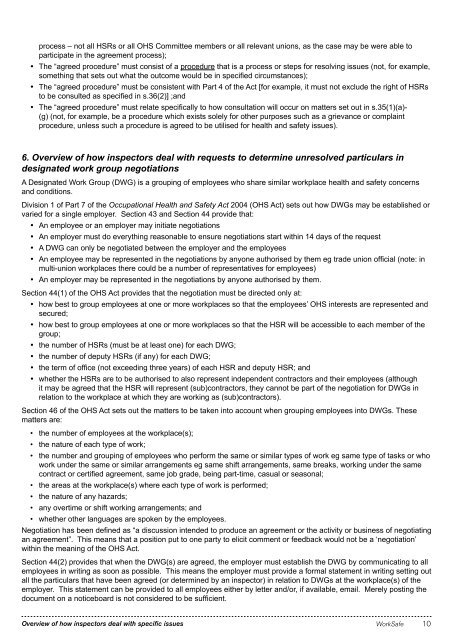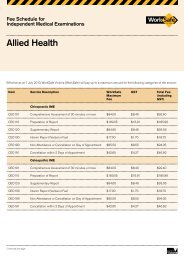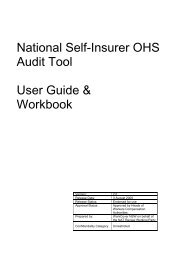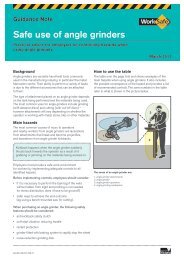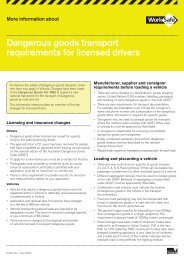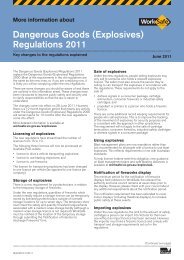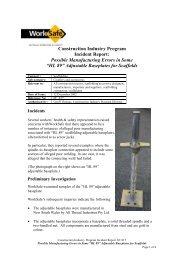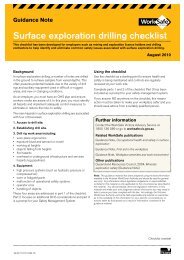process – not all HSRs or all OHS Committee members or all relevant unions, as the case may be were able toparticipate in the agreement process);• The “agreed procedure” must consist <strong>of</strong> a procedure that is a process or steps for resolving issues (not, for example,something that sets out what the outcome would be in specified circumstances);• The “agreed procedure” must be consistent <strong>with</strong> Part 4 <strong>of</strong> the Act [for example, it must not exclude the right <strong>of</strong> HSRsto be consulted as specified in s.36(2)] ;and• The “agreed procedure” must relate <strong>specific</strong>ally to <strong>how</strong> consultation will occur on matters set out in s.35(1)(a)-(g) (not, for example, be a procedure which exists solely for other purposes such as a grievance or complaintprocedure, unless such a procedure is agreed to be utilised for health and safety issues).6. <strong>Overview</strong> <strong>of</strong> <strong>how</strong> <strong>inspectors</strong> <strong>deal</strong> <strong>with</strong> requests to determine unresolved particulars indesignated work group negotiationsA Designated Work Group (DWG) is a grouping <strong>of</strong> employees who share similar workplace health and safety concernsand conditions.Division 1 <strong>of</strong> Part 7 <strong>of</strong> the Occupational Health and Safety Act 2004 (OHS Act) sets out <strong>how</strong> DWGs may be established orvaried for a single employer. Section 43 and Section 44 provide that:• An employee or an employer may initiate negotiations• An employer must do everything reasonable to ensure negotiations start <strong>with</strong>in 14 days <strong>of</strong> the request• A DWG can only be negotiated between the employer and the employees• An employee may be represented in the negotiations by anyone authorised by them eg trade union <strong>of</strong>ficial (note: inmulti-union workplaces there could be a number <strong>of</strong> representatives for employees)• An employer may be represented in the negotiations by anyone authorised by them.Section 44(1) <strong>of</strong> the OHS Act provides that the negotiation must be directed only at:• <strong>how</strong> best to group employees at one or more workplaces so that the employees’ OHS interests are represented andsecured;• <strong>how</strong> best to group employees at one or more workplaces so that the HSR will be accessible to each member <strong>of</strong> thegroup;• the number <strong>of</strong> HSRs (must be at least one) for each DWG;• the number <strong>of</strong> deputy HSRs (if any) for each DWG;• the term <strong>of</strong> <strong>of</strong>fice (not exceeding three years) <strong>of</strong> each HSR and deputy HSR; and• whether the HSRs are to be authorised to also represent independent contractors and their employees (althoughit may be agreed that the HSR will represent (sub)contractors, they cannot be part <strong>of</strong> the negotiation for DWGs inrelation to the workplace at which they are working as (sub)contractors).Section 46 <strong>of</strong> the OHS Act sets out the matters to be taken into account when grouping employees into DWGs. Thesematters are:• the number <strong>of</strong> employees at the workplace(s);• the nature <strong>of</strong> each type <strong>of</strong> work;• the number and grouping <strong>of</strong> employees who perform the same or similar types <strong>of</strong> work eg same type <strong>of</strong> tasks or w<strong>how</strong>ork under the same or similar arrangements eg same shift arrangements, same breaks, working under the samecontract or certified agreement, same job grade, being part-time, casual or seasonal;• the areas at the workplace(s) where each type <strong>of</strong> work is performed;• the nature <strong>of</strong> any hazards;• any overtime or shift working arrangements; and• whether other languages are spoken by the employees.Negotiation has been defined as “a discussion intended to produce an agreement or the activity or business <strong>of</strong> negotiatingan agreement”. This means that a position put to one party to elicit comment or feedback would not be a ‘negotiation’<strong>with</strong>in the meaning <strong>of</strong> the OHS Act.Section 44(2) provides that when the DWG(s) are agreed, the employer must establish the DWG by communicating to allemployees in writing as soon as possible. This means the employer must provide a formal statement in writing setting outall the particulars that have been agreed (or determined by an inspector) in relation to DWGs at the workplace(s) <strong>of</strong> theemployer. This statement can be provided to all employees either by letter and/or, if available, email. Merely posting thedocument on a noticeboard is not considered to be sufficient.<strong>Overview</strong> <strong>of</strong> <strong>how</strong> <strong>inspectors</strong> <strong>deal</strong> <strong>with</strong> <strong>specific</strong> issues<strong>WorkSafe</strong> 10
Section 44(3) provides that the parties to an agreement may negotiate a variation <strong>of</strong> that agreement at any time. Section44(4) provides that if a variation is agreed, the employer must vary the agreement by communicating the change to allemployees in writing as soon as possible, in the manner described above.Determination by inspector <strong>of</strong> unresolved particularsSection 45 sets out where agreement is not reached <strong>with</strong>in a reasonable time any party to the negotiation may ask<strong>WorkSafe</strong> <strong>Victoria</strong> to arrange for an inspector to determine the particulars that are unresolved and the inspector must takeinto account the matters identified in s.46.An inspector will make enquiries <strong>of</strong> all relevant parties to obtain an understanding <strong>of</strong> their positions and why theparticular(s) remain unresolved. The inspector will meet first <strong>with</strong> the party making the request, and will obtainconfirmation from employee(s) that any representative is authorised by them.If the request for an inspector’s determination relates to DWG negotiations for multiple employers, <strong>inspectors</strong> do not havepower to determine unresolved particulars and will provide guidance for negotiating multiple employer DWGs and arrangefor the issue to be referred (through the Advisory Service) as a service request to <strong>WorkSafe</strong> <strong>Victoria</strong>’s Workplace Supportand Education Division for support and assistance.If particulars are resolved during discussions <strong>with</strong> the parties, the inspector will ask the requesting party to <strong>with</strong>drawtheir request for a determination. Otherwise, the inspector will provide a Notice <strong>of</strong> Determination <strong>of</strong> DWG UnresolvedParticulars (either at that time or in due course if further consideration is required). It is <strong>WorkSafe</strong> <strong>Victoria</strong> Policy that<strong>inspectors</strong> inform the relevant workplace parties <strong>of</strong> their right to seek review <strong>of</strong> the inspector’s determination and providea copy <strong>of</strong> the Authority-approved form for such application to the person(s) if requested to do so.CoercionSection 53 <strong>of</strong> the OHS Act prohibits coercion <strong>of</strong> workplace parties when they are attempting to establish or negotiateDWGs, vary DWG agreements and in relation to representation in negotiations. It is an <strong>of</strong>fence to:• pressure someone not to make, or to <strong>with</strong>draw, a request for a DWG under s.43,• intimidate someone into not being represented in the negotiations, or• intimidate someone into being represented by a particular person.An inspector will make preliminary enquiries into such an allegation and – if it appears the allegation is substantiated – willconsider referral for comprehensive investigation.7. <strong>Overview</strong> <strong>of</strong> <strong>how</strong> <strong>inspectors</strong> <strong>deal</strong> <strong>with</strong> requests to conduct an election <strong>of</strong> HSRs and/ordeputy HSRsSection 54(4) <strong>of</strong> the Occupational Health and Safety Act 2004 (OHS Act) provides that members <strong>of</strong> a Designated WorkGroup (DWG) can determine <strong>how</strong> an election for a HSR is to be conducted. The employer has no role in determining <strong>how</strong>an election is to be conducted except where an employer who is a natural person is part <strong>of</strong> the relevant DWG.Section 54(4) <strong>of</strong> the OHS Act also provides that if members <strong>of</strong> a DWG, whether <strong>of</strong> a single employer or multiple employers,cannot reach agreement <strong>with</strong>in a reasonable time on <strong>how</strong> to elect their HSR or deputy HSR, any member <strong>of</strong> the DWGmay ask Worksafe <strong>Victoria</strong> to arrange for an inspector to conduct the election. The only other role under the OHS Act for<strong>inspectors</strong> is provision <strong>of</strong> guidance or advice on election matters.The election process is identical for both the election <strong>of</strong> HSR and deputy HSR. However, if an election is required <strong>of</strong> bothroles and an inspector is requested to assist, the inspector will run two parallel but separate elections. A person may wishto nominate for a deputy HSR, if they are not elected as HSR. This would involve two elections, one following the other.The relevant inspector (<strong>with</strong> endorsement <strong>of</strong> their Industry Program Director) may appoint the <strong>Victoria</strong>n Electoral Commission(VEC) or another person to conduct the election(s) on <strong>WorkSafe</strong>’s behalf. A decision made by an inspector to appoint aperson to conduct an election <strong>of</strong> a HSR is a reviewable decision. It is <strong>WorkSafe</strong> <strong>Victoria</strong> Policy that <strong>inspectors</strong> informthe relevant workplace parties <strong>of</strong> this right and provide a copy <strong>of</strong> the Authority-approved form for such application to theperson(s) if requested to do so.Section 54(5) <strong>of</strong> the OHS Act provides that an election must be conducted in accordance <strong>with</strong> the procedures (if any)prescribed by the regulations. There are currently no such regulations.The inspector, having determined the request was made by a DWG member, will meet first <strong>with</strong> the DWG member makingthe request and then separately <strong>with</strong> other relevant members <strong>of</strong> the DWG to obtain views about the disagreement. Theinspector will provide advice on conduct <strong>of</strong> elections. If the DWG members reach agreement during discussions, theinspector will ask the requesting party to <strong>with</strong>draw their request for an inspector to conduct the election(s). Otherwise, theinspector will proceed to conduct the election(s) or have the VEC or other person appointed to conduct the election(s).<strong>Overview</strong> <strong>of</strong> <strong>how</strong> <strong>inspectors</strong> <strong>deal</strong> <strong>with</strong> <strong>specific</strong> issues<strong>WorkSafe</strong> 11


